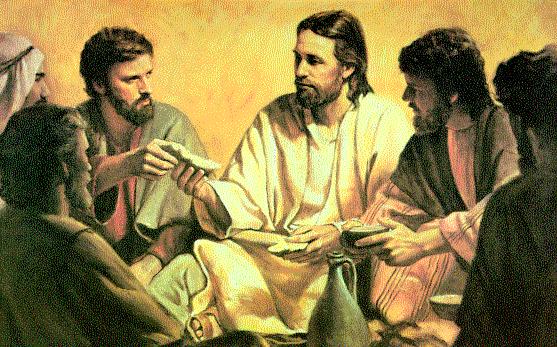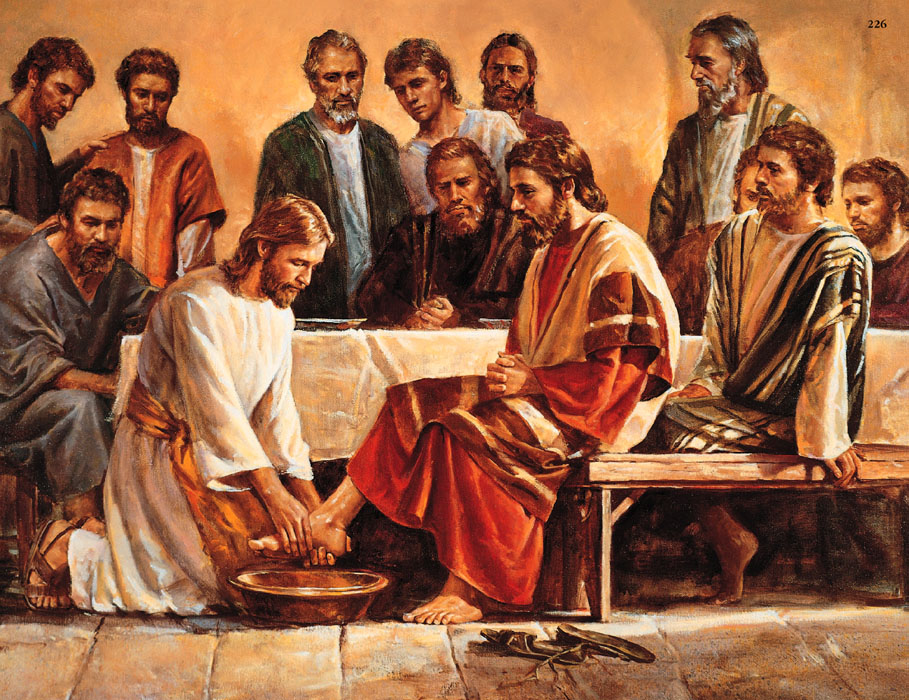In Luke 22:7–30 we read an account of Christ’s last meal on earth, the Passover, which He celebrated with His apostles in an upper room in Jerusalem. Mormons believe that Jesus Christ, as Jehovah, is the LORD who usually speaks in the Old Testament. He is the one who delivered commandments to Moses on Mount Sinai, including the commandments to observe high holy days centered upon the temple (then the tabernacle in the wilderness). Although these seven holy convocations are described in the Old Testament, most of the pattens and symbolic meanings of the holidays are found in the oral law. These patterns and symbols are so rich with Messianic imagery, that they lay out the important events of Christ’s ministry as well as the basic religious history of the world. None of these holy days is as richly endowed with Messianic imagery than the Passover.
 The Paschal Lamb itself is a symbol of the Savior. Firstborn, without blemish, and sacrificed in sorrow with no bones broken, Christ is called the Passover by Paul in 1 Corinthians 5:7: “Purge out therefore the old leaven, that ye may be a new lump, as ye are unleavened. For even Christ our passover is sacrificed for us.” This Paschal Lamb, Christ, was born in a stable on Passover, and then sacrificed as the Paschal Lamb on Passover, Thursday, April 3, 33 A.D. Because the Essenes and Nazarenes celebrated an eight-day Passover festival, as had been ordained during the Exodus, and because the Pharisees had already contracted it to a seven-day festival by the time of Christ, Jesus hung on the cross as the same time the Paschal lambs were being offered in the temple courtyard.
The Paschal Lamb itself is a symbol of the Savior. Firstborn, without blemish, and sacrificed in sorrow with no bones broken, Christ is called the Passover by Paul in 1 Corinthians 5:7: “Purge out therefore the old leaven, that ye may be a new lump, as ye are unleavened. For even Christ our passover is sacrificed for us.” This Paschal Lamb, Christ, was born in a stable on Passover, and then sacrificed as the Paschal Lamb on Passover, Thursday, April 3, 33 A.D. Because the Essenes and Nazarenes celebrated an eight-day Passover festival, as had been ordained during the Exodus, and because the Pharisees had already contracted it to a seven-day festival by the time of Christ, Jesus hung on the cross as the same time the Paschal lambs were being offered in the temple courtyard.
According to Jewish tradition, a quorum of 10 people were expected to share a feast of lamb, and every celebrant was required to partake a piece at least the size of an olive. The Romans could approximate the number of citizens and pilgrims in Jerusalem for the feast by numbering the sacrificial animals and multiplying by ten. In the year of Cestius, when Jerusalem was laid siege by the Romans and destroyed, 250,000 lambs were offered (Josephus).
Traditionally, the oldest male member of the extended family — those joining together for the feast — would preside at the feast. This final Passover, then, may have been the only one wherein Jesus presided. The one presiding was also the one who offered the sacrifice. Thus, at this one Passover, Jesus was both the offerer and the offering.
Who needeth not daily, as those high priests, to offer up sacrifice, first for his own sins, and then for the people’s: for this he did once, when he offered up himself (Hebrews 7:27).
Symbols of the Passover Meal
The Jewish Passover was the celebration of their deliverance from Egypt, symbolic of the world. This was a spiritual rebirth, as well as a physical one, and required a symbolic baptism — the Israelites were delivered through water, the Red Sea, into a wilderness of testing, on their way to the Promised Land. This was an enactment of the Plan of Salvation. They were delivered from worldliness, had to depend on God’s grace in the desert, and were delivered into heaven, symbolically.
Redemption is the central message of the Passover. At the meal celebrants recited the Exodus story to prove that God is a God of miracles and will deliver His children. Messiah is also central to the ritual. The Lamb represents Messiah, but so does the unleavened bread, which must be pierced and striped to prevent it from rising. All must partake of a portion of the unleavened bread, called the afikoman, which is broken, blessed, wrapped in white cloth, and “buried,” resurrected, and shared. The Christ-imagery is obvious.
During the feast, Christ used the unleavened bread to testify of Himself. Celebrants had been partaking of it looking forward to Messiah, and now He told them to do it in remembrance from that time forward. The same with the wine, representing one’s cup of joy. Each cup partaken of during the feast represented a covenant, and Christ refused the sacramental cup, which represented the gift of the Promised Land forever, for this is a millennial promise not yet fulfilled. Christ told the Prophet Joseph Smith that He would again partake of the fruit of the vine when He comes again the second time, in a great convocation with all the prophets, and all those who had followed Him in righteousness. (See Doctrine and Covenants 27:4-14.)
At the Passover it is traditional not to eat or drink anything again after the afikoman and final cup promising a return to Jerusalem, after it becomes a sanctified and holy city. And we have no record of Christ partaking of any food or drink from this moment on. He went directly to Gethsemane, betrayal, judgment, flogging, mocking, and crucifixion.
The Washing of Feet
 When Christ insisted upon washing the feet of His apostles, saying Peter could “have no part” with Him unless this was performed, He was performing an ordinance that sealed upon the apostles eternal life in God’s presence. (See Doctrine and Covenants 88.)
When Christ insisted upon washing the feet of His apostles, saying Peter could “have no part” with Him unless this was performed, He was performing an ordinance that sealed upon the apostles eternal life in God’s presence. (See Doctrine and Covenants 88.)
The Crucifixion
According to research performed by Nazarene (Messianic) Jewish scholars, there were no Friday Passovers during the twenty years surrounding Christ’s crucifixion. John says Jesus was taken off the cross for the Sabbath, but this may have not been the typical Saturday Sabbath, since John says it was “an high day.” (See John 19:31.) It is possible to have two or even three sabbaths in a row on Jewish holy days. Thus, it is entirely possible that the Passover Sabbath was on Friday (beginning Thursday night), then the normal sabbath was on Saturday, and Jesus was resurrected on Sunday, which was another high holy day…
Bikkurim
 The high holy day of Bikkurim, a name derived from “honored son,” was to be celebrated on the Sunday occurring during the Passover week. Pilgrims had gathered at the temple for the pilgrimage holiday of Passover, but they were required to bring with them the grain they had harvested the year before. Although a harvest had already occurred before Passover, the new grain could not be eaten until after Bikkurim.
The high holy day of Bikkurim, a name derived from “honored son,” was to be celebrated on the Sunday occurring during the Passover week. Pilgrims had gathered at the temple for the pilgrimage holiday of Passover, but they were required to bring with them the grain they had harvested the year before. Although a harvest had already occurred before Passover, the new grain could not be eaten until after Bikkurim.
A field was planted adjacent to the temple by the high priests. It could not be watered or fed, nor attended to in any way. As Jesus grew up without the need for being taught, so this field had to grow up unto itself. A perfect sheaf of grain was selected and set apart by the priests, then harvested and offered as a wave offering in the temple on Bikkurim. This offering promised a perfect harvest for the rest of the year. Christ was resurrected as this wave offering was presented, the first-fruits of the resurrection, a resurrection that would be perfect, since all living things will be resurrected and enjoy immortality, men and women, also, no matter whether they have been righteous or wicked.
Christ, by ordaining these symbolic holidays during Old Testament times, was trying to prepare His Chosen People to recognize Him when He would serve His earthly ministry. Some were indeed prepared, and they were those who read the scriptures, were privy to personal revelation, and who were courageous enough to follow Him. These were the beginning of Christ’s church on earth.
Additional Resources:
The Book of Mormon: Another Testament of Jesus Christ
